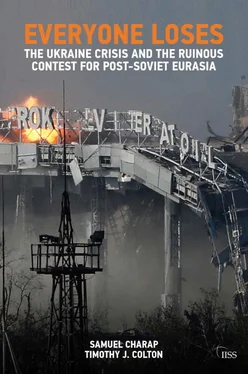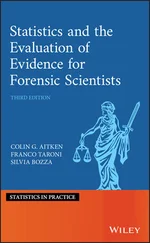The troubles in Ukraine began as an essentially internal affair. In November 2013 a crackdown on students demonstrating against the government’s decision not to sign an agreement to link the country more closely with the EU led to a mammoth street protest in the capital city, Kyiv. Several months of clashes between the authorities and the protesters produced, unexpectedly for all, the violent overthrow in February 2014 of a harsh and erratic but democratically elected president, Viktor Yanukovych, in what came to be known as the Maidan Revolution. The domestic imbroglio blew up into an international confrontation in March when Russian President Vladimir Putin ordered measures taken to occupy and then annex the Crimean peninsula, situated on Ukraine’s Black Sea coast.
While the Crimea operation produced few casualties, thousands have died since Moscow supported unrest in the Donbas area of eastern Ukraine, along the land border with Russia. Consisting of the provinces of Donetsk (pre-conflict population 4.4 million) and Luhansk (2.2m), the Donbas hosted a high concentration of the country’s mining and metallurgy and was the political base of Yanukovych and his Party of Regions. Separatist ‘people’s republics’, with material and moral support from Russia, were declared in both pieces of the Donbas in April 2014. A Ukrainian military operation to quell the rebellion began that spring and within months had forced a rebel retreat. Late that summer, regular Russian units – far better equipped and trained than their Donbas separatist comrades – intervened directly. The resulting setback for Ukrainian forces produced negotiations that led to a ceasefire deal, signed in Minsk, Belarus, on 5 September. It broke down within weeks. A second and more robust pact was signed on 12 February 2015, again in Minsk, following another punishing Russian intervention.
The crumbling of the first of the two Minsk agreements resulted in large part from the battle for control of the airport of the city of Donetsk, the provincial capital. This event serves as a powerful reminder of the destructive forces at work. Located ten kilometres northwest of central Donetsk, the facility was officially called Sergei Prokofiev International Airport, in honour of the world-renowned composer, a native of Donetsk province. Prokofiev was born there when it was part of the Russian Empire in the late nineteenth century, but lived and worked from 1936 until his death in 1953 in the USSR, specifically in what is now Russia. [1] Prokofiev’s music was considered ‘formalist’ by Communist Party ideologists. For this reason and because of his long period of exile, he did his work as something of a pariah, but he was never arrested or harmed. In a striking coincidence, Prokofiev died on the same day (5 March 1953) as the Soviet dictator Joseph Stalin.
While he identified as an ethnic Russian, Prokofiev inserted into his works motifs from the Ukrainian folk songs he had heard as a child. The airfield, first constructed by Soviet engineers in the 1940s, was renovated at great cost in 2011–12 as part of the preparations for the European football championship of 2012, co-hosted by Ukraine and Poland. Shiny and modern, the passenger terminal seemed to reflect the relative prosperity the Ukrainian industrial heartland had come to enjoy, as well as the country’s increased international standing.
On 26 May 2014, insurgents loyal to the self-proclaimed Donetsk People’s Republic (DNR) seized the airport. By the next evening, the Ukrainian military and pro-government militias had wrested back control. In the months that followed, they used the now-inoperative airport as a base to shell Donetsk city, the rebel stronghold. Accordingly, separatist forces began in late September to try to reverse their earlier defeat. In stages, this monument to inter-ethnic cooperation and the promise of globalisation was demolished. One by one, the air-traffic control tower, the new and old terminals, hangars, fuel-storage tanks, equipment sheds and a hotel were reduced to rubble or to charred hulks. The facility finally fell to the separatists in January 2015, by which time it looked like Second World War-era Stalingrad and was littered with broken glass, booby traps and burned-out vehicles. Sporadic fighting has continued around the defunct airport.
The tragedy of the grinding siege of the Sergei Prokofiev International Airport is that around 700 human beings died over a superfluous asset. The DNR had no air force, and in any event artillery rendered the runways useless during the first round of fighting. Ukrainian ground forces could have fired at the city, if they had so wished, from more readily defensible wooded areas nearby. The September truce had called for the airport to be ceded to the rebels. But Ukrainian soldiers remained encamped there in violation of the terms. They stayed because the glare of the television cameras made retreat to safety politically unattractive for their commanders and the leadership in Kyiv. On national television, these troops were lionised as ‘cyborgs’, super-human fighting machines prepared to battle to the death, as if the airport were a latter-day Alamo. Unlike the Alamo in Texas, however, this site had no military value to speak of. And, unlike the Mexicans who besieged the Alamo in 1836, the rebels here allowed the Ukrainian defenders to rotate in and out for several months, subject to inspection. [2] One of many eye-opening video presentations of the cyborgs’ activity may be found at https://www.youtube.com/watch?v=3Pf3HjUwtWU&feature=youtu.be .
The wrecked airport serves as an apt symbol for the gestalt we observe in the Ukraine crisis. Game theorists classify the result of a dispute or negotiation in one of three main categories. In a zero-sum game, one party gains from the interaction and the other correspondingly loses, with the respective winnings and losses adding up to zero. Hypothetical illustrations would be a competition between two unemployed persons over a single desirable job, or between two passengers in a sinking yacht over the one available life raft. In a positive-sum game, both actors benefit. For instance, negotiations over shares in a fixed pie of resources could produce insights into how to enlarge the pie so that both parties get more valuable slices than before, or the yacht passengers could find a way to activate a second life raft so that both of them survive. In a negative-sum interaction, by contrast, the pie or pool of available benefits shrinks, because of contextual changes or choices made by the parties involved, and each of them ends up worse off at the end of the day. In the theory of games, negative-sum interactions are appreciated as the ones that will generate the most severe discomfort and discord as the players work their way through them.
In our estimation, the best metaphor for the conflict in and over Ukraine is that of the negative-sum game, a ruinous scenario in which every major player loses. [3] We are aware that up to a point gains and losses are in the eye of the beholder, that in the real world they may come in mixed packages, and that even individuals who agree on objectives and strategy may disagree about the success or failure of actions they have taken collectively. Throughout this book, we do our best to make detached and objective assessments of gains and losses, while acknowledging that others, particularly those directly involved in the process, might use different metrics.
As far as Ukraine is concerned, its overall condition has degraded markedly since the crisis erupted in 2014. No one can be sure exactly how many Ukrainians have died in the fighting in the Donbas. The United Nations Office for the Coordination of Humanitarian Affairs puts the toll at about 10,000 as of August 2016. Almost 3m people have been forced from their homes. Much of the Donbas’s vaunted stock of mines and industrial assets has been destroyed. Countless dwellings in the towns and cities of the region have been razed or smashed by indiscriminate shelling, as have electricity, water, sewage and other utilities.
Читать дальше











